Lamb meat comes from lamb or sheep while pork is meat from pigs. Pork is a fairly popular choice while lamb takes some getting used to for most people which is a crying shame given the potential that lamb has for amazing dinners.
I have been a grill chef for thirty years and my customers are constantly asking me whether lamb is the healthier choice compared to pork and which of the two, if any, they should cut out of their diet. My answer is always the same. Both types of meat are tasty and healthy components of a larger balanced diet.
In this article, I will outline the characteristics of both these types of meat and give you a comparative breakdown of their respective nutritional composition so that you have a better grasp of the benefits of adding both lamb and pork to your diet.
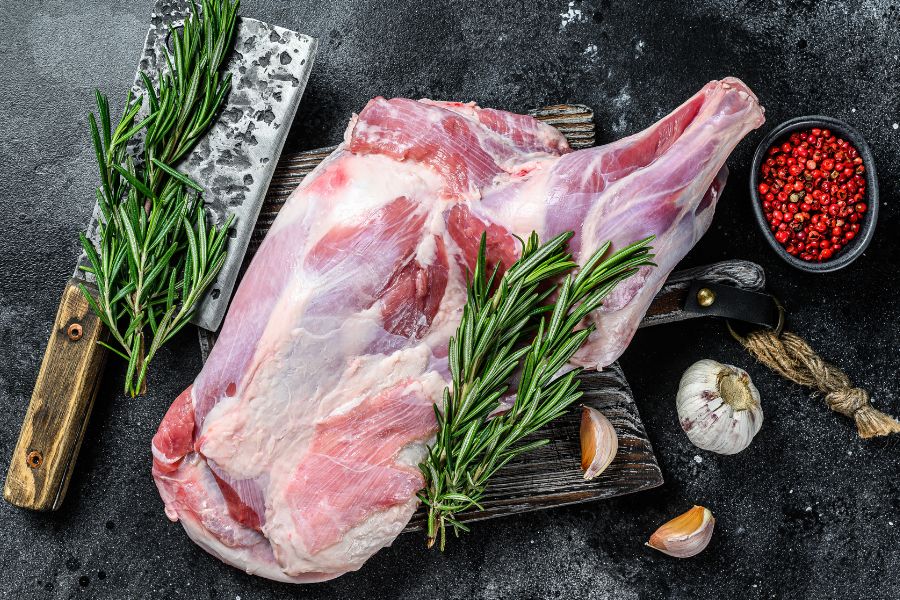
Both lamb and pork can be used in many recipes and have a lot of potential for delicious flavorful meals if you prepare and cook them just right. Like all meats, it is important to understand the characteristics of the meat you have as well as the cut you have to get the best results.
Characteristic | Lamb | Pork |
Flavor | Intense, gamey | Subtle or Bland |
Serving Temperature | 145 Degrees Fahrenheit | 145 Degrees Fahrenheit |
Methods of Preparation | Does Not Require Marinating or Curing | Often Requires Marination or Curing to Infuse Flavor |
Texture | Tender and Juicy | Less Tender and Juicy Compared to Lamb |
Cost | Costlier Than Pork | Cheaper Than Lamb |
Lamb tends to have a richer stronger flavor that can be as overwhelming as it is delicious. It may take some getting used to but if you are not a fan of strong gamey flavors then lamb might not be the ideal choice for you.
That said, the flavor of lamb mingles beautifully with strongly flavored herbs such as rosemary, mint, and thyme making the end dish so savory and tasty it will blow your mind.
The high-fat content contained in lamb means that it cooks very well and the tender chunks absorb flavor rather easily.
Pork, on the other hand, has a softer more subtle flavor. Some lean cuts can even be considered bland and almost devoid of flavor. This may be one of the reasons some people are insistent that it is white meat alongside chicken. It is not.
Pork often requires the input of stronger more flavorful intense spices and ingredients to turn it into a savory dish. Some cuts such as the shoulder and the hams need curing and marination to infuse flavor and make the pork more interesting for your taste buds.
The recommended serving temperature for lamb and pork steaks and roasts should be a minimum of 145 degrees Fahrenheit.
At this temperature, the meat will remain juicy and tender while also destroying pathogens and preventing food-borne illnesses that may be contracted by consuming unsafe raw meat.
In the interest of safety, it may be safe to go somewhat higher but lamb is an incredibly tender kind of meat that may become chewy when subjected to too much heat.
Pork tenderloin which is very tender also can be ruined by high temperatures and long cooking times causing it to lose its moisture content and dry out.
That said, as an experienced griller, I can tell you that some cuts such as pork butt which have a high amount of connective tissue cannot be cooked to readiness at such a low temperature.
These require a much higher cooking temperature of up to 195 – 200 degrees Fahrenheit to break down the fibers to an edible tenderness. Even then, the meat needs to be marinated overnight just to break down the fibers before cooking.
For ground lamb and pork patties, the recommended serving temperature should not be below 160 degrees Fahrenheit. Ground meats expose a larger surface area to oxygen which makes them susceptible to faster microbial action.
To be certain, when cooking lamb and pork steaks, it is recommended that you utilize a food thermometer to ensure the interior of the steak has reached the recommended temperatures.
I have been using the ThermoPro Grilling Thermometer, which I found to be reliable and accurate. Over time, you should be able to play it by ear and cook without the use of the thermometer.
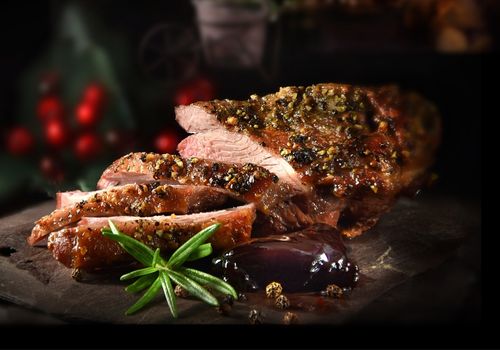
For any type of meat you choose, the preparation comes down to the type of cut that you are working with. The toughness or tenderness can vary based on the part of the animal that it comes from.
Shoulders and legs tend to have a tougher texture overall because they are the muscles responsible for holding up the animal as well as movement. The ribs tend to have more tender cuts since they are the fattier portions.
This informs the cooking methods, the temperature needed to cook it, and the length of time needed to cook it to the perfect tenderness.
Lamb is considerably more tender compared to pork and the higher fat content of the meat in general adds to this quality.
The stronger fuller flavor of lamb means that lamb does not require curing and marinating to make it more flavorful while pork is suitable for marinating to infuse the chunks with flavor.
In fact, lamb could be ruined by marinating especially if the spices are so strong that they interfere with the natural flavor of lamb.
Pork essentially becomes more tasty and strong spices only bring out the flavor of pork making for a great combination.
Tougher lamb cuts such as shoulders can be tenderized effectively by using a simple mallet tenderizer or a Jaccard meat tenderizer instead of using spices and salt to cure the meat. This way, the flavor stays intact and the meal ends up tender.
Lamb is softer and more tender compared to pork. Pork hams are not tender and require curing to break down the meat. With lamb, even the tough cuts do not need much preparation or tenderization to make them juicy and easy to chew.
The texture of meats is also affected by farming practices such as the type of feed that the animal has been feeding on. Grass-fed lamb may not have the same tenderness quality as grain-fed lamb depending on the different metabolisms of different animals and breeds.
The age of the animal also dictates the texture of the eventual cuts. Most of the available lamb comes from year-old sheep which means it is likely to be tender and juicy.
Older sheep slaughtered beyond this time period will likely produce tougher cuts of meat since older animals have tougher muscle fibers and have had more use of their muscles, toughening the carcass.
Lamb is more expensive than pork and while the numbers may vary from state to state, the cost difference remains. This is because sheep take much longer to reach market weight compared to other animals that are raised for meat production, with the exception of cows.
This yields greater expense to rear them for commercial purposes.
Even when slaughtered at approximately one year which is early enough to offset these expenses, sheep will not yield a large amount of useable meat from the carcass so whether young or mature enough for slaughter, sheep do not produce much meat which makes them less profitable for commercial farming.
If you have access to a sheep farm then you are in luck. Freshly slaughtered lamb meat is your best bet for a more affordable cut. The lamb that you get from butcher shops costs slightly higher than what you could order from a farm near you.
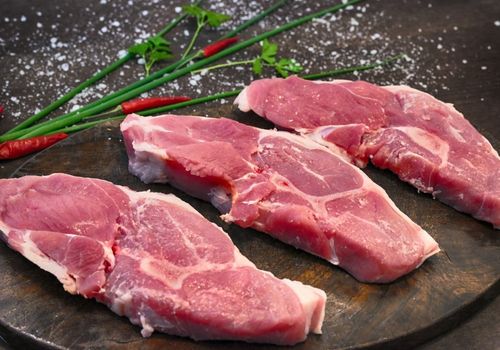
Pork, lamb, and other red meats are excellent sources of protein, fats, and iron. That said, the two types of meat are red meat which means they are associated with health risks such as cardiovascular disease, the occurrence of diabetes, and the increase of cholesterol in the body.
Red meats are often touted as the source and cause of many health problems and the temptation to exclude red meats from one’s diet is understandable. There is, however, no conclusive evidence that red meat will cause any of the diseases associated with it.
While a correlation can be argued, an exact causal relationship has not been established.
The exact relationship between pork, lamb, beef, or any meat with these ailments is still being investigated. However, often enough, it is safe to assume that overindulgence in red meat should be avoided, while maintaining a healthy intake to benefit from the positive effects of consuming red meat.
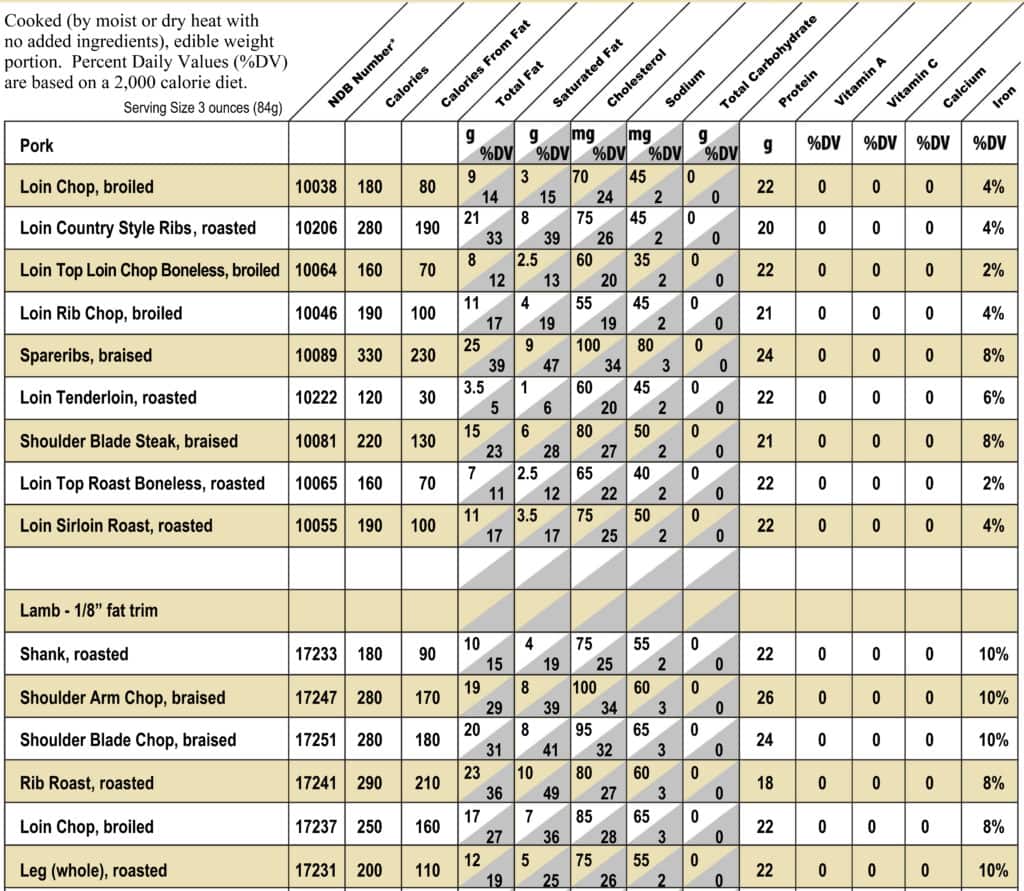
The comparison above is of cooked lamb and pork portions of 83 grams each or 3 oz. Find the full nutritional summary of lamb vs pork in this table. The exact nutrition values range based on the cut of meat.
Different cuts are likely to have different nutrient densities. For instance, areas with more fat and marbling will likely have higher total fat and saturated fat values compared to the leanest cuts of the animal.
Some important nutrients such as omega-3 fatty acids can be found in pork and lamb but in such trace amounts that pork and lamb are not considered great sources. There are far richer sources such as fish, nuts, and fortified foods.
It’s not. Based on the nutrition information in the tables above, lamb meat contains higher amounts of calories, total and saturated fats, cholesterol, and sodium. These are some of the substances that place consumers in danger of developing the health risks associated with red meat.
The difference is, however, not significant enough to make pork automatically the healthier choice either. Lamb contains more iron than pork which makes it a better source of iron.
Additionally, neither lamb nor pork is healthier than beef or any of the other red meats. Even the leanest choices will contain varying amounts of the nutrients and substances such as sodium and cholesterol that are associated with health problems.
Red meats provide the necessary protein and fat to maintain healthy cells overall and both pork and lamb are excellent sources of both.
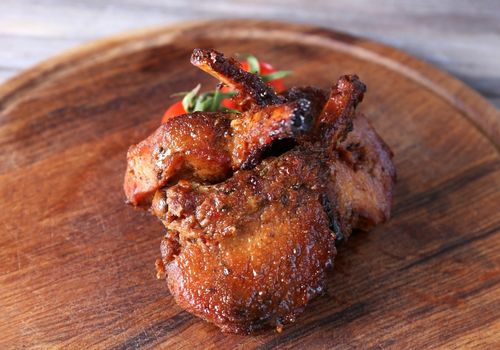
Lamb vs pork is certainly an interesting consideration. Both meat types are valid if not great substitutes for the beef and chicken we all love and consume quite regularly.
If you want to spruce up your recipes, it would be interesting to include either of these two meat types in your cooking.
If your concern is health, don’t worry. According to the above-verified figures from the USDA, the differences in crucial nutrients between lamb meat and pork does not sufficiently place any one of these meat types ahead of the other.
A healthy life does not necessarily involve the total absence of red meat, saturated fat, or sodium in your diet. The essential aspect of any diet is a moderated intake of many nutrient groups to create a healthy lifestyle in general.
As for flavor profiles, I recommend that you eat lamb meat if you have never done so. As a fan of this meat, I can assure you that it’s a different culinary experience, and given the strong gamey flavor of the meat coupled with its softer texture, your cooking will be easy and yield a delicious and tasty meal.